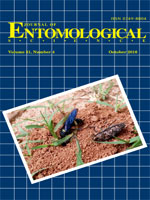Western flower thrips, Frankliniella occidentalis (Pergande), are one of the most-destructive insect pests of greenhouse-grown horticultural crops worldwide due to the direct and indirect damage they cause to plants. Western flower thrips induce direct damage by feeding on leaves and flowers and also cause indirect damage by vectoring certain tospoviruses including Impatiens necrotic spot and Tomato spotted wilt viruses. As a result, the threshold for this insect pest is near zero. Consequently, the primary means of suppressing populations of western flower thrips in greenhouse production systems is the application of insecticides. In general, insecticides are inexpensive, easy to apply, and relatively effective. However, the selection pressure placed on western flower thrips populations due to intensive applications of insecticides has resulted in severe problems associated with the development of resistance. Therefore, in order to avoid the prospect of insecticide resistance developing in western flower thrip populations, greenhouse producers must implement a multitude of plant protection strategies including scouting, insecticide rotations, insecticide mixtures, and the use of alternative insecticides (e.g., entomopathogenic fungi and insect growth regulators) with broad-spectrum modes of action.
How to translate text using browser tools
1 October 2016
Western Flower Thrips (Thysanoptera: Thripidae) and Insecticide Resistance: An Overview and Strategies to Mitigate Insecticide Resistance Development
R.A. Cloyd
ACCESS THE FULL ARTICLE
insecticides
plant protection
resistance
selection pressure





